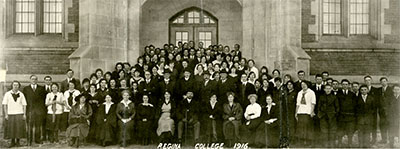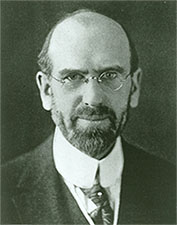
|

|

|
"...unless relief is speedily obtained the college will simply have to go out of business..."*
 Regina College with Saskatchewan Legislative Building in backgoundSituated on College Avenue, at Scarth Street, Regina College was established by the Methodist Church of Canada in 1911 to offer academic, music and business training to students in Regina and the surrounding area. Classes began on September 5, 1911 for 27 students who enrolled in the first year of the new College's existence. The Reverend Wilbur William Andrew was the College's first President.
Regina College with Saskatchewan Legislative Building in backgoundSituated on College Avenue, at Scarth Street, Regina College was established by the Methodist Church of Canada in 1911 to offer academic, music and business training to students in Regina and the surrounding area. Classes began on September 5, 1911 for 27 students who enrolled in the first year of the new College's existence. The Reverend Wilbur William Andrew was the College's first President.
Just after 2 p.m. October 25, 1911, proceedings began to officially open the College with a cornerstone-laying ceremony, which included a reading from the Bible (Proverbs , Chapters 8 and 9, which references wisdom, that it is available to everyone and that it is everlasting). Inside the cornerstone were placed a Bible, documents relating to the College's establishment, postage stamps and coins from both Queen Victoria and King Edward's reigns, and the trowel that was used to apply the grout between the bricks, which was then presented to His Honour Lieutenant Governor George W. Brown.
The three years following its opening were a struggle for the young College, staffing, financial, and other administrative issues and later World War I saw the College run into a dire situation. By the recession in 1913 subscribers who had been keeping the College afloat with installments were not able to keep up. Borrowing money from a bank was not an option. There was a war on and sacrifices of all kinds had to be made. Three board members and four teachers enlisted. 128 students enlisted and were given a gold watch and automatic credit for the full year of college work.
 Regina College Faculty & Students 1916The number of girls enrolled at the College increased during the war years and in 1915 there were 148 male students and 182 female students. In 1918 there were 185 male students while the female students numbered 405. Students who were not enlisted showed support for the troops by rolling bandages, knitting socks for the Red Cross and making up Christmas parcels. As was told to the students at the College, the war needed to be fought in order to uphold the principles of freedom and democracy, which were, at the time, represented by the British Empire. Students further voted to support the war effort by closing down recreational centres such as movie theatres and pool rooms for the remainder of the war.
Regina College Faculty & Students 1916The number of girls enrolled at the College increased during the war years and in 1915 there were 148 male students and 182 female students. In 1918 there were 185 male students while the female students numbered 405. Students who were not enlisted showed support for the troops by rolling bandages, knitting socks for the Red Cross and making up Christmas parcels. As was told to the students at the College, the war needed to be fought in order to uphold the principles of freedom and democracy, which were, at the time, represented by the British Empire. Students further voted to support the war effort by closing down recreational centres such as movie theatres and pool rooms for the remainder of the war.
The 4 year-old, half-built College implemented cuts to services and supplies. Utilities such as power, fuel, and water were conserved and insurance on the schools boiler was cancelled for a year in order to save money. Everyone took a cut in pay as it was felt that it was better to have some pay than to close down the college all together. In 1918 the College's art teacher, Inglis Sheldon-Williams, was called away to paint for the Canadian War Memorial Commission at the request of the Canadian Government.
 Ernest W. StaplefordThe situation for the College, by each progressing war year, was becoming more and more dire; it was seen as increasingly closer to shutting its doors in bankruptcy. No real progress had been made on the completion of its buildings or of the financial stability once dreamed of in the early planning stages of the College. President of the College from 1913 to March 1915, Robert Milliken, had enough of the never-ending crises and resigned. Reverend Ernest William Stapleford became the third President of the young College. This enigmatic man would eventually turn the College toward a path of success with his skill in the art of 'selling' the potential of the College to those who could help support and sustain it with financial contributions. Night classes were offered as a way of reaching an even greater number of students, war ended and the College's financial stability solidified. Stapleford, during the 22 years he guided the college, completed the girl's residence and had raised funds for the construction of a central heating plant, a gymnasium, and the F.N. Darke Music and Art Building, now known as Darke Hall.
Ernest W. StaplefordThe situation for the College, by each progressing war year, was becoming more and more dire; it was seen as increasingly closer to shutting its doors in bankruptcy. No real progress had been made on the completion of its buildings or of the financial stability once dreamed of in the early planning stages of the College. President of the College from 1913 to March 1915, Robert Milliken, had enough of the never-ending crises and resigned. Reverend Ernest William Stapleford became the third President of the young College. This enigmatic man would eventually turn the College toward a path of success with his skill in the art of 'selling' the potential of the College to those who could help support and sustain it with financial contributions. Night classes were offered as a way of reaching an even greater number of students, war ended and the College's financial stability solidified. Stapleford, during the 22 years he guided the college, completed the girl's residence and had raised funds for the construction of a central heating plant, a gymnasium, and the F.N. Darke Music and Art Building, now known as Darke Hall.
In 1920 a bronze memorial tablet was unveiled to honour those from Regina College students who served in World War I, the mother of one of these, Mrs. C.W. Rogers pulled the Union Jack flag away and off of the plaque while those watching listened as George Friedrich Händel's Dead March (from Saul) played.
* Pitsula, J. M. (1988). An act of faith: The early years of Regina College. Regina, SK: Canadian Plains Research Center

|

|

|
